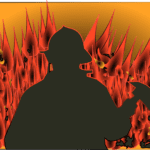Is your residential building prepared for a fire? Preventing fires is obviously important, but what happens when a fire breaks out? Are you prepared? Do your tenants know what to do?
Fires are a big risk for residential buildings. Each year, an estimated 380,200 residential building fires were reported to fire departments within the United States from 2013 to 2015. These fires caused an estimated 2,695 deaths; 12,000 injuries; and $7 billion in property loss. (FEMA)
Statistics indicate that early warning from a smoke alarm and a fire escape plan that is practiced regularly can save lives. Smoke alarms were not present in 22 percent of non-confined fires in occupied residential buildings.
A large proportion of reported fires without smoke alarms may reflect the effectiveness of the alarms themselves: Smoke alarms do not prevent fires, but they may prevent a fire from being reported if it is detected at an early stage and extinguished before the fire department becomes involved.
Alternatively, fires in homes without smoke alarms may not be detected at an early stage, causing them to grow large, require fire department intervention, and thus be reported.
Since smoke alarms double the chance of a family surviving a fire, it is crucial to have several operational ones in all units. Smoke detectors should be on every living level and in every sleeping room.
Smoke alarms should be tested once a month and change the batteries every 6 months regardless of whether they seem to need it. A common rule of thumb is to change the batteries of the smoke alarms when you change the clocks.
Fire Escape Plan
Having and practicing a fire escape plan is crucial for any residential unit. Current escape plans can help everyone leave quickly and safely:
- Create an escape route that provides two possible exits from each room, such as a window or door.
- Do not use any windowless rooms as bedrooms.
- Keep escape routes clear of clutter and do not use escape routes as storage areas so that no one trips and falls on the way out during an emergency.
- Print out copies of the fire escape route and make sure that all people living in the unit know the plan and practice it as least twice a year.
- Each person should be able to safely escape in less than two minutes.
- Ensure that all windows can be easily opened, screens can be easily taken out and security bars can be opened.
- Make sure that if there are any visually impaired people they should have smoke alarms with audible capabilities.
- If there are any hearing impaired people living in the unit, make sure that the unit if outfitted with a vibrated pad or flashing lights.
- If there are any people who need special assistance, make sure that the fire escape route keeps their special needs in mind. Designate a specific person who can help them.


